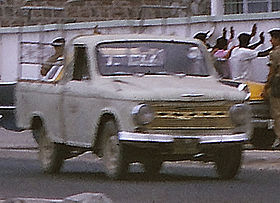Hino Briska
| Hino Briska | |
|---|---|

1961 Hino Briska Light Duty Truck
|
|
| Overview | |
| Manufacturer | Hino Motors |
| Production | April 1961–1968 |
| Assembly | Hamura, Tokyo, Japan |
| Body and chassis | |
| Class | compact truck |
| Body style | pickup delivery van (1960-1962) |
| Layout | FR layout |
| Related |
Hino Contessa Hino Commerce |
| Chronology | |
| Successor | Toyota Hilux |
| FG series | |
|---|---|

A Hino Briska in Aden, Yemen in 1966
|
|
| Overview | |
| Manufacturer | Hino Motors |
| Production | April 1961–1965 |
| Assembly |
Hamura, Tokyo, Japan Haifa, Israel |
| Powertrain | |
| Engine | 893 cc GP20 I4 |
| Transmission | 4-speed manual |
| Dimensions | |
| Wheelbase | 2,230–2,295 mm (87.8–90.4 in) |
| Length | 3,840–4,150 mm (151.2–163.4 in) |
| Width | 1,620 mm (63.8 in) |
| Height | 1,640 mm (64.6 in) |
| Curb weight | 935 kg (2,061 lb) |
| Chronology | |
| Successor | FH series |
| FH series/GY10 | |
|---|---|
| Overview | |
| Manufacturer | Hino Motors |
| Also called | Toyota Briska |
| Production | 1965–1968 |
| Assembly |
Hamura, Tokyo, Japan Haifa, Israel |
| Powertrain | |
| Engine | 1,251 cc GR100 I4 |
| Transmission | 4-speed manual |
| Dimensions | |
| Wheelbase | 2,520 mm (99.2 in) |
| Length | 4,275 mm (168.3 in) |
| Width | 1,640 mm (64.6 in) |
| Height | 1,595 mm (62.8 in) |
| Curb weight | 1,080 kg (2,381 lb) |
| Chronology | |
| Predecessor | FG series |
| Successor | Toyota Hilux |
The Hino Briska was a small pickup truck built by Hino Motors, adapted from the Renault-based Hino Contessa sedan. It was first introduced in 1961 and remained in production until 1968, when Toyota released the Toyota Hilux. In 1967, the Hino Briska was renamed the Toyota Briska, then the Hilux was introduced, based on the Briska. There was also a commercial delivery van, appropriately called the .
The Briska was introduced in March 1961 at exhibitions in 32 cities across Japan. Called the FG10, it used a Hitachi-Stromberg carburetor on a modified version of the Contessa's engine, itself derived from that of the Renault 4CV. In March 1962, the Briska lineup added a longer version with a second bench seat for rear seat passengers (FG20P, also available in a panel van version called FG20V).
The body style with the single bench seat could carry a payload of 750 kg (1,653 lb), while the crew cab could accommodate 400 kg (882 lb). In September 1962 the longer FG30 arrived (also as FG30P and V), now on a slightly longer wheelbase and upgraded for a 850 kg (1,874 lb) payload. The Briska was the first Japanese produced truck to accommodate three passengers on a single bench seat, according to the Japanese Governments Ministry of Posts and Telecommunications. The panel delivery van (FG20V/FG30V) was only built for two years due to lack of sales. In 1963, the engine was uprated from the original 35 PS (26 kW; 35 bhp) to 40 PS (29 kW; 39 bhp). This also meant that top speed increased, from 91 to 100 km/h (57 to 62 mph).
When the Contessa entered its second generation, the Briska was also modified and received a larger 1,251 cc engine with 55 PS (40 kW). Hino entered into a partnership with Toyota in 1966, with Hino focusing on large commercial trucks and Toyota focusing on lighter vehicles. The four-speed manual transmission received synchronization only on the top three gears. As of April 1967 and until the end of production, the truck was sold as the Toyota Briska using the model code GY10. The Toyota Briska received twin headlights and a slightly more powerful engine with 63 PS (46 kW; 62 bhp). The succeeding Hilux was built by Hino factories for Toyota while Hino's truck sales were still low.
Hino Motors signed a 10-year assembly agreement with Kaiser-Illin Industries of Haifa, Israel, in 1963. Assembly of the Contessa 900 started in 1964. Later, Briska 900 and 1300 and the Contessa 1300 sedan were assembled in Haifa as well. During the years 1964-1965, Israel was Hino's second most important market for its Contessas. Israel exports amounted to ~10% of total Contessa production. After it was purchased by Toyota, the contract was terminated and the very last Israeli Contessas rolled off the assembly line in March 1968. In total, over 8,000 Hino Contessa and Briska were assembled in Israel.
...
Wikipedia
